Compressible Diagnosis of Membrane Fouling Based on Transfer Entropy
Abstract
1. Introduction
- (1)
- Based on the mechanism analysis associated with membrane fouling, the relationship between causal variables and membrane fouling is clarified with the feature extraction algorithm. Then, the related variables of membrane fouling are obtained under different operating conditions. Different from the data-driven diagnosis models in [15,16,17,18,19] with given causal variables, the feature extraction algorithm will enable the proposed CDM to transform raw data into informative representations that can be utilized for diagnosis.
- (2)
- Instead of using a mapping relationship with simple input–output representation such as decision trees [21,22] and the Bayesian network [24,25], a topology based on transfer entropy is constructed. This approach not only provides a qualitative evaluation of the causal relationships between variables by observing the dynamic transfer path, but it also offers a quantitative description of those variables. It helps uncover the path of fault occurrence and further obtain the fault cause priority that may change over time as the operating conditions change.
- (3)
- The information compressible strategy (ICS) is designed to delete redundant or repetitious affiliation relationships between the causal variables. With this strategy, the simplified FTT is obtained with low complexity during the update of fault transfer topology, which can maintain the diagnosis of membrane fouling speedily and accurately.
2. Background of Membrane Fouling
2.1. Membrane Fouling
2.2. Membrane Fouling Diagnosis System
3. Methodology
3.1. Feature Variable Selection
- ➀
- The data of the independent variable is given as P = [p1, p2, …, pj], pj= (p1j, p2j, …, pij)T, i = 1, 2, …, m, j = 1, 2, …, n, and the dependent variable Q = [q1, q2,…, qi]T. The standard treatment is as follows:where the standardized P and Q are recorded as E0 and F0. and represent the elements in E0 and F0, respectively. and sj represent the average value and standard deviation of the elements in column j of P, respectively. and s represent the average value and standard deviation of all elements in Q, respectively. and can be expressed by
- ➁
- The principal component of the variable is found via the following formula:where h is the number of extracted principal components. Eh is the standardized independent variable matrix when h components are extracted. Fh is the standardized dependent variable matrix when h components are extracted. vh is the component extracted from Eh−1. ah, bh and rh represent the intermediate vectors.
- ➂
- The cross-validity is used to determine the number of final extracted components withwhere L(h) and LL(h) can be expressed bywhere is the dth (0 < d ≤ h + 1) element in F0, and represents the fitting quantity. Sample point d is deleted when modeling with the linear regression model, and h components are taken for regression modeling to obtain the coefficients αi. Then, the fitting value of the dth sample point is calculated and recorded as . Additionally, all sample points are used, and h components are taken for regression modeling to obtain coefficients ςi. Finally, the fitting value of the dth sample point is calculated and recorded as .
3.2. Membrane Fouling Detection Model
3.3. Construction of Fault Transfer Topology
3.4. Simplification of Fault Propagation Topology
4. Results and Discussion
4.1. The Feature Variables
4.2. Results of Membrane Fouling Detection Model
4.3. Results of Membrane Fouling Diagnosis Model
4.4. Discussion of Results
- (1)
- Good detection. It is essential for the CDM to identify incidents of membrane fouling with specific causal variables. The proposed autoencoder can summarize thresholds by RMSE for any membrane fouling, assuming it covers the entire normal conditions of the MBR. These thresholds can serve as a reference for operators to monitor the occurrence of membrane fouling without the need for a physical or mathematical model. The results in Figure 6 and Figure 7 also illustrate the efficacy of this method.
- (2)
- Intuitive diagnosis. By constructing a fault transfer topology with the CDM in Figure 8, the dynamic observation of causal relationships between variables facilitates the determination of causal factors leading to membrane fouling. Additionally, to eliminate repetitive affiliation relationships, the fault transfer topology is simplified using an information compressible strategy, as shown in Figure 9 and Figure 10. Table 2 also demonstrates that the proposed CDM significantly enhances the speed and accuracy of diagnosis.
5. Conclusions
Author Contributions
Funding
Institutional Review Board Statement
Informed Consent Statement
Data Availability Statement
Conflicts of Interest
References
- Lu, X.; Wang, J.; Han, Y.; Zhou, Y.; Song, Y.; Dong, K.; Zhen, G. Unrevealing the role of in-situ Fe(II)/S2O82− oxidation in sludge solid–liquid separation and membrane fouling behaviors of membrane bioreactor (MBR). Chem. Eng. J. 2022, 434, 134666. [Google Scholar] [CrossRef]
- Tanis-Kanbur, M.B.; Tamilselvam, N.R.; Chew, J.W. Membrane fouling mechanisms by BSA in aqueous-organic solvent mixtures. J. Ind. Eng. Chem. 2022, 108, 389–399. [Google Scholar] [CrossRef]
- Cui, Z.; Wang, X.; Ngo, H.; Zhu, G. In-situ monitoring of membrane fouling migration and compression mechanism with improved ultraviolet technique in membrane bioreactors. Bioresour. Technol. 2022, 347, 126684. [Google Scholar] [CrossRef] [PubMed]
- Heo, S.; Nam, K.; Woo, T.; Yoo, C. Digitally-transformed early-warning protocol for membrane cleaning based on a fouling-cumulative sum chart: Application to a full-scale MBR plant. J. Membr. Sci. 2022, 643, 120080. [Google Scholar] [CrossRef]
- Ruigómez, I.; González, E.; Rodríguez-Gómez, L.; Vera, L. Fouling control strategies for direct membrane ultrafiltration: Physical cleanings assisted by membrane rotational movement. Chem. Eng. J. 2022, 436, 135161. [Google Scholar] [CrossRef]
- Sutrisna, P.D.; Kurnia, K.A.; Siagian, U.W.R.; Ismadji, S.; Wenten, I.G. Membrane fouling and fouling mitigation in oil–water separation: A review. J. Environ. Chem. Eng. 2022, 10, 107532. [Google Scholar] [CrossRef]
- Yao, J.; Wu, Z.; Liu, Y.; Zheng, X.; Zhang, H.; Dong, R.; Qiao, W. Predicting membrane fouling in a high solid AnMBR treating OFMSW leachate through a genetic algorithm and the optimization of a BP neural network model. J. Environ. Manag. 2022, 307, 114585. [Google Scholar] [CrossRef]
- Wu, X.H.; Gao, Y.T. Generalized Darboux transformation and solitons for the Ablowitz–Ladik equation in an electrical lattice. Appl. Math. Lett. 2023, 137, 108476. [Google Scholar] [CrossRef]
- Suo, Y.; Chen, S.; Ren, Y. Research on the influence of polyaluminum chloride and benzotriazole on membrane fouling and membrane desalination performance. J. Environ. Chem. Eng. 2021, 9, 106676. [Google Scholar] [CrossRef]
- Li, S.; Chen, P.; Maddela, N.R.; Yang, X.; Chen, S.; Feng, J.; Zhang, S.; Zhang, L. Effects of filtration modes on fouling characteristic and microbial community of bio-cake in a membrane bioreactor. J. Environ. Chem. Eng. 2022, 10, 107465. [Google Scholar] [CrossRef]
- Zhang, C.; Bao, Q.; Wu, H.; Shao, M.; Wang, X.; Xu, Q. Impact of polysaccharide and protein interactions on membrane fouling: Particle deposition and layer formation. Chemosphere 2022, 296, 134056. [Google Scholar] [CrossRef] [PubMed]
- Lewis, W.J.T.; Mattsson, T.; Chew, Y.M.J.; Bird, M.R. Investigation of cake fouling and pore blocking phenomena using fluid dynamic gauging and critical flux models. J. Membr. Sci. 2017, 533, 38–47. [Google Scholar] [CrossRef]
- Vrouwenvelder, J.S.; Manolarakis, S.A.; van der Hoek, J.P.; van Paassen, J.A.M.; van der Meer, W.G.J.; van Agtmaal, J.M.C.; Prummel, H.D.M.; Kruithof, J.C.; van Loosdrecht, M.C.M. Quantitative biofouling diagnosis in full scale nanofiltration and reverse osmosis installations. Water Res. 2008, 42, 4856–4868. [Google Scholar] [CrossRef] [PubMed]
- Wang, Y.; Sanly; Brannock, M.; Leslie, G. Diagnosis of membrane bioreactor performance through residence time distribution measurements-a preliminary study. Desalination 2009, 236, 120–126. [Google Scholar] [CrossRef]
- Azizighannad, S. Raman imaging of membrane fouling. Sep. Purif. Technol. 2020, 242, 116763. [Google Scholar] [CrossRef]
- Nam, K.; Heo, S.; Rhee, G.; Kim, M.; Yoo, C. Dual-objective optimization for energy-saving and fouling mitigation in MBR plants using AI-based influent prediction and an integrated biological-physical model. J. Membr. Sci. 2021, 626, 119208. [Google Scholar] [CrossRef]
- Liu, J.; Kang, X.; Luan, X.; Gao, L.; Tian, H.; Liu, X. Performance and membrane fouling behaviors analysis with SVR-LibSVM model in a submerged anaerobic membrane bioreactor treating low-strength domestic sewage. Environ. Technol. Innov. 2020, 19, 100844. [Google Scholar] [CrossRef]
- Han, H.G.; Zhang, H.J.; Liu, Z.; Qiao, J.F. Data-driven decision-making for wastewater treatment process. Control Eng. Pract. 2020, 96, 104305. [Google Scholar] [CrossRef]
- Mittal, S.; Gupta, A.; Srivastava, S.; Jain, M. Artificial neural network based modeling of the vacuum membrane distillation process: Effects of operating parameters on membrane fouling. Chem. Eng. Process.-Process Intensif. 2021, 164, 108403. [Google Scholar] [CrossRef]
- Chen, H.-S.; Yan, Z.; Zhang, X.; Liu, Y.; Yao, Y. Root cause diagnosis of process faults using conditional granger causality analysis and maximum spanning tree. IFAC-PapersOnLine 2018, 51, 381–386. [Google Scholar] [CrossRef]
- Waghen, K.; Ouali, M.-S. Multi-level interpretable logic tree analysis: A data-driven approach for hierarchical causality analysis. Expert Syst. Appl. 2021, 178, 115035. [Google Scholar] [CrossRef]
- Shen, Y.; Tian, B.; Zhou, T.Y.; Cheng, C.D. Multi-pole solitons in an inhomogeneous multi-component nonlinear optical medium, Chaos. Solitons Fractals 2023, 171, 113497. [Google Scholar] [CrossRef]
- Gao, X.T.; Tian, B. Water-wave studies on a (2+1)-dimensional generalized variable-coefficient Boiti–Leon–Pempinelli system. Appl. Math. Lett. 2022, 128, 107858. [Google Scholar] [CrossRef]
- Duan, P.; He, Z.; He, Y.; Liu, F.; Zhang, A.; Zhou, D. Root cause analysis approach based on reverse cascading decomposition in QFD and fuzzy weight ARM for quality accidents. Comput. Ind. Eng. 2020, 147, 106643. [Google Scholar] [CrossRef]
- Arias Velásquez, R.M.; Mejía Lara, J.V. Root cause analysis improved with machine learning for failure analysis in power transformers. Eng. Fail. Anal. 2020, 115, 104684. [Google Scholar] [CrossRef]
- Amin, M.T.; Khan, F.; Ahmed, S.; Imtiaz, S. A data-driven Bayesian network learning method for process fault diagnosis. Process Saf. Environ. Prot. 2021, 150, 110–122. [Google Scholar] [CrossRef]
- Wang, J.; Yang, Z.; Su, J.; Zhao, Y.; Gao, S.; Pang, X.; Zhou, D. Root-cause analysis of occurring alarms in thermal power plants based on Bayesian networks. Int. J. Electr. Power Energy Syst. 2018, 103, 67–74. [Google Scholar] [CrossRef]
- Han, H.G.; Dong, L.X.; Qiao, J.F. Data-knowledge-driven diagnosis method for sludge bulking of wastewater treatment process. J. Process Control 2021, 98, 106–115. [Google Scholar] [CrossRef]

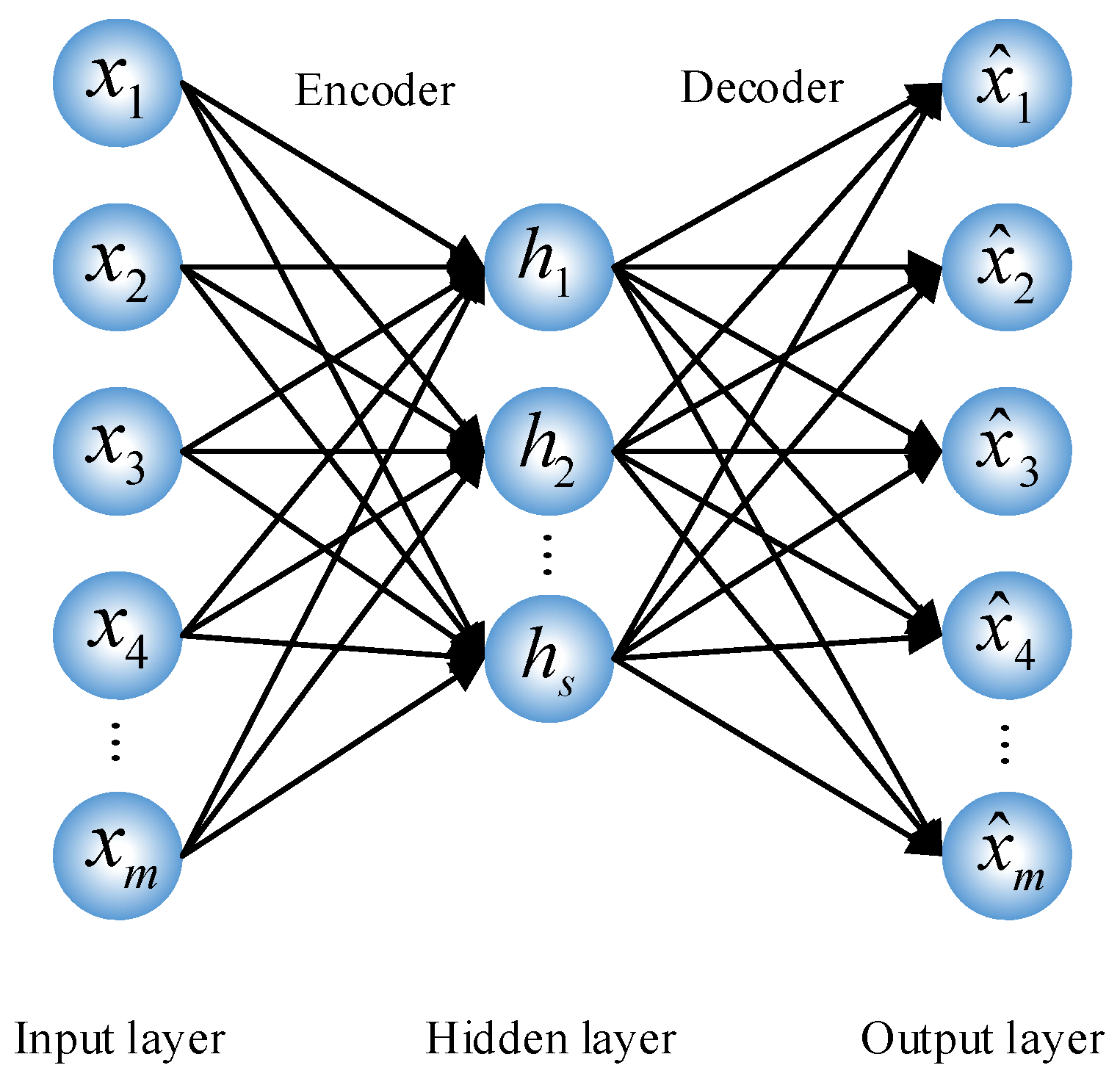


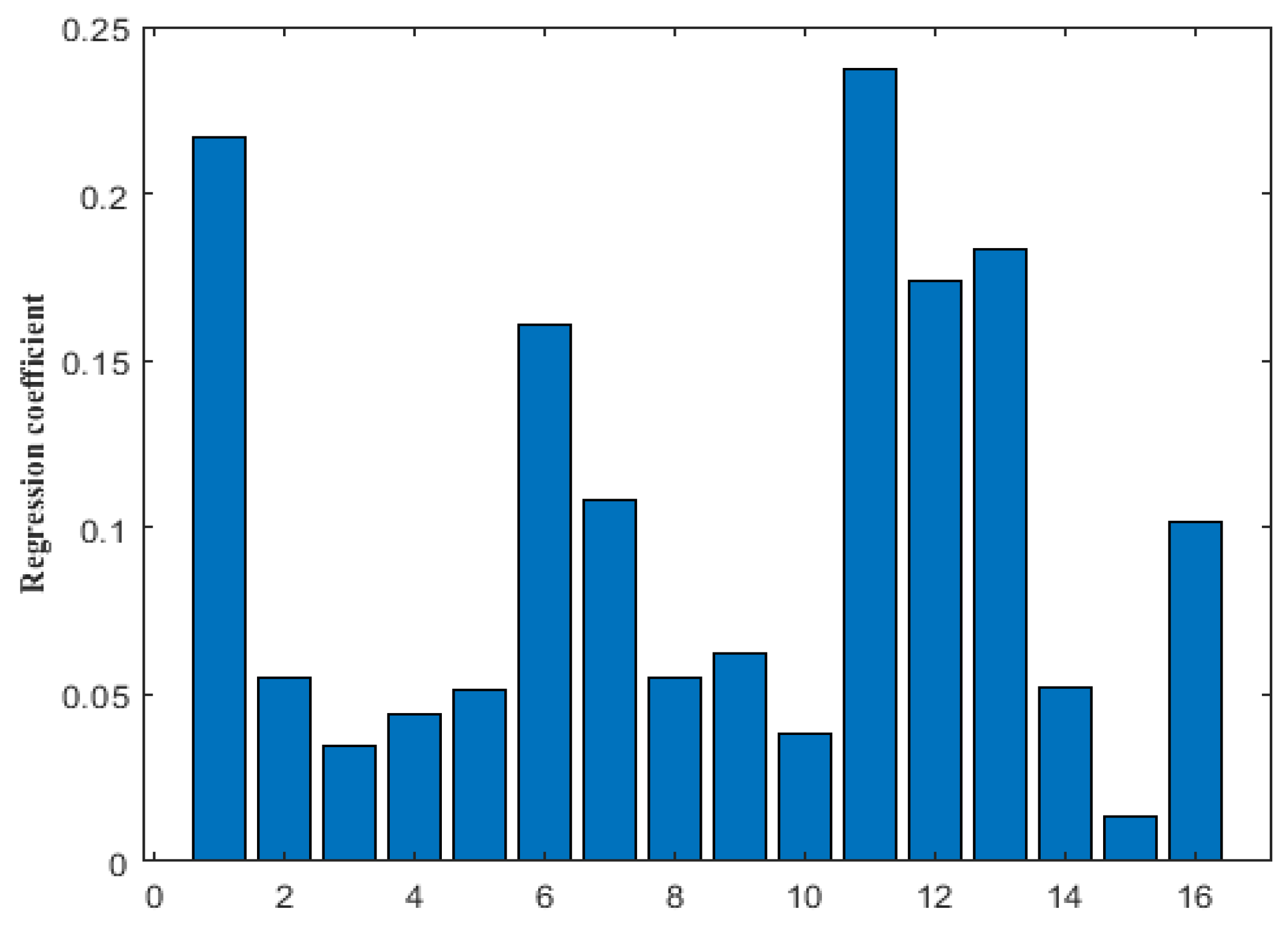

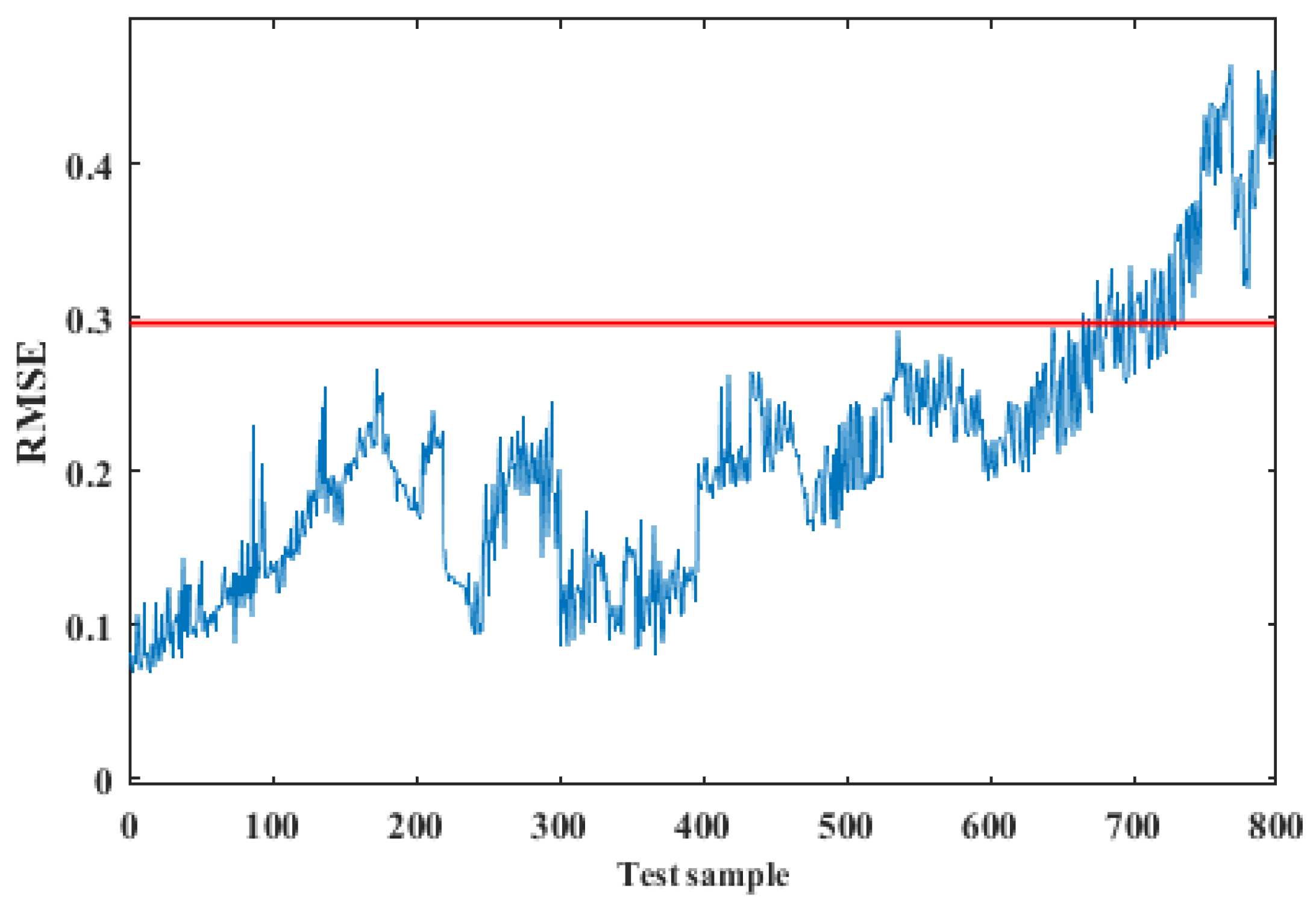
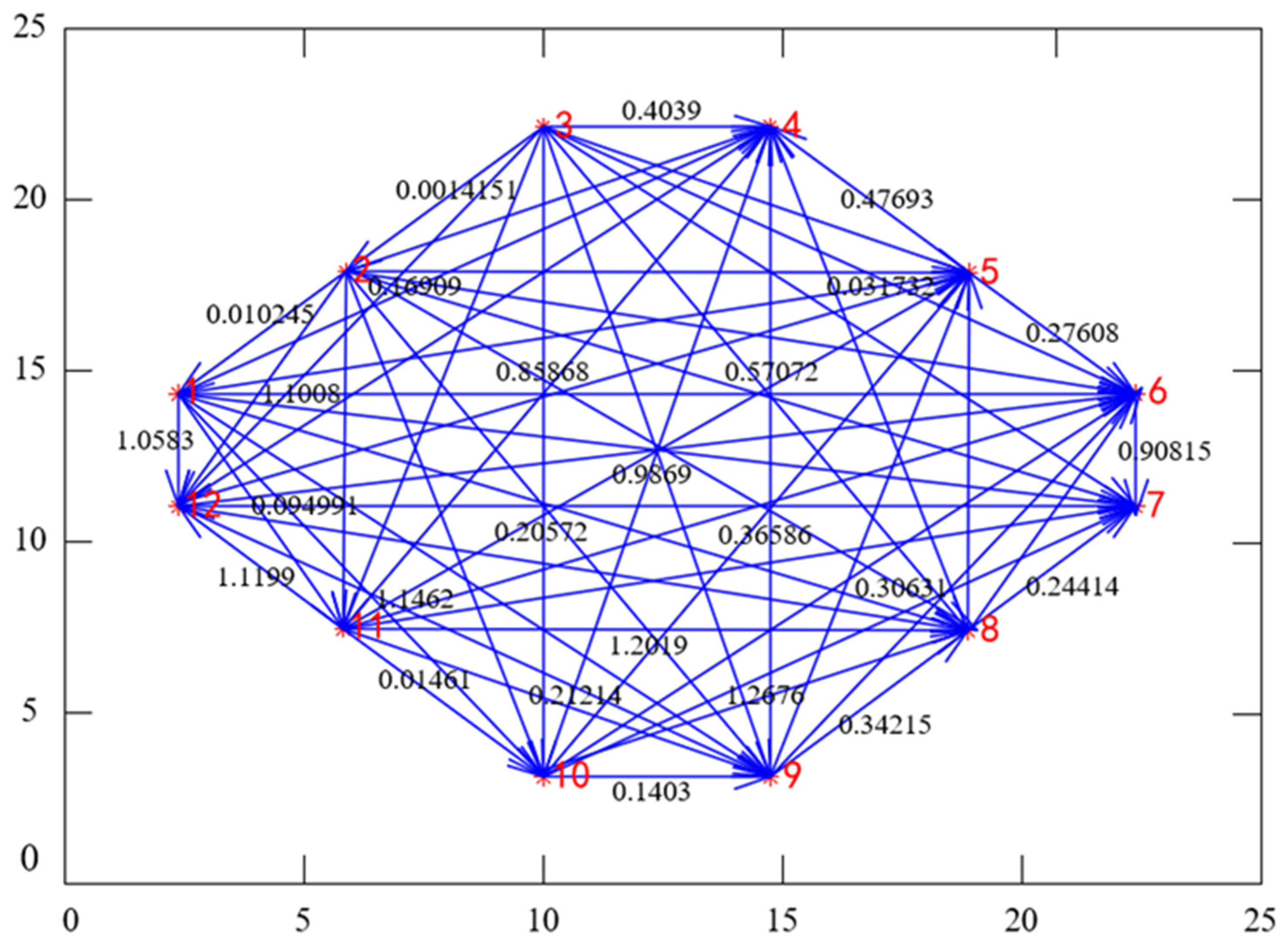
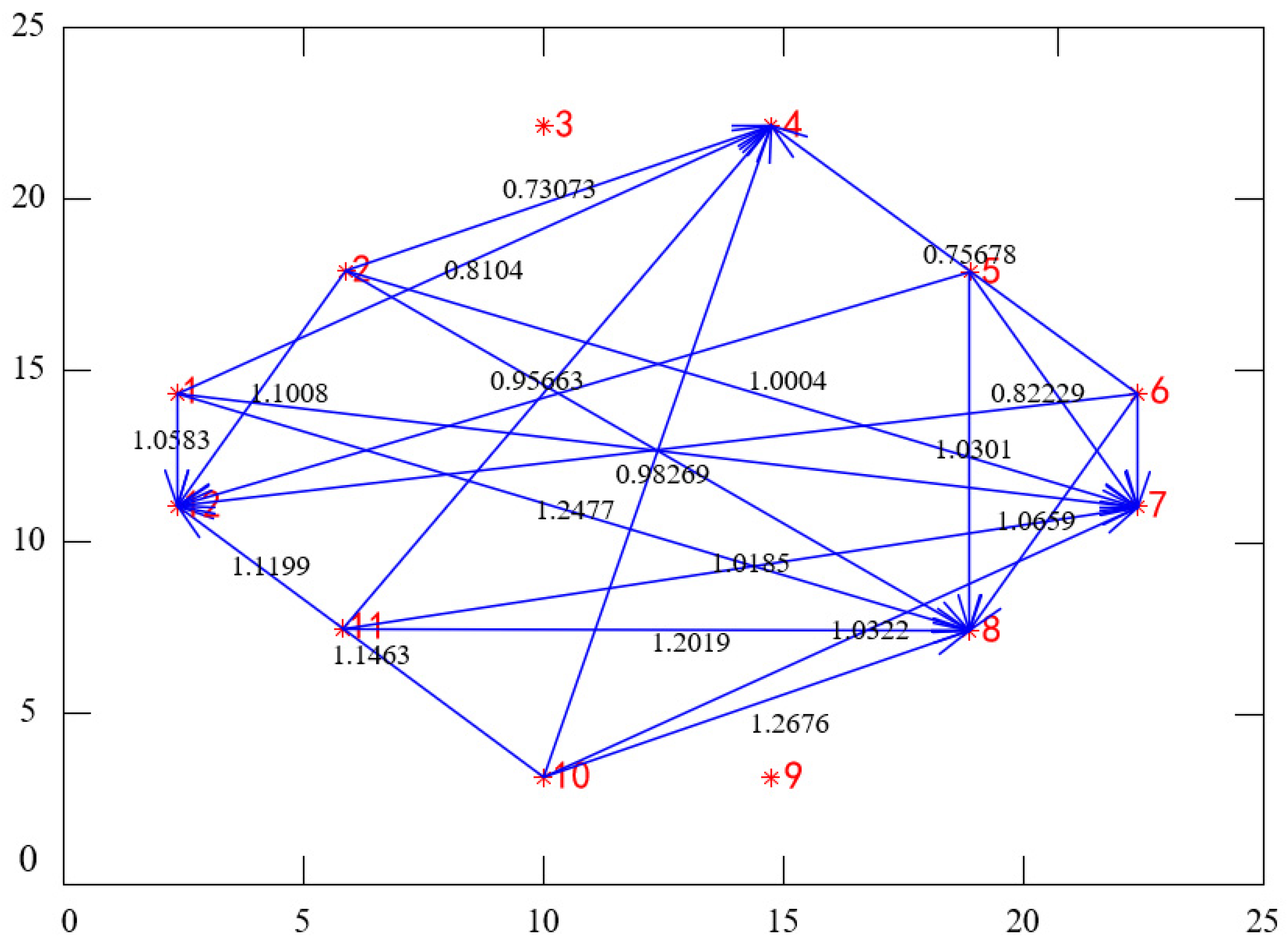
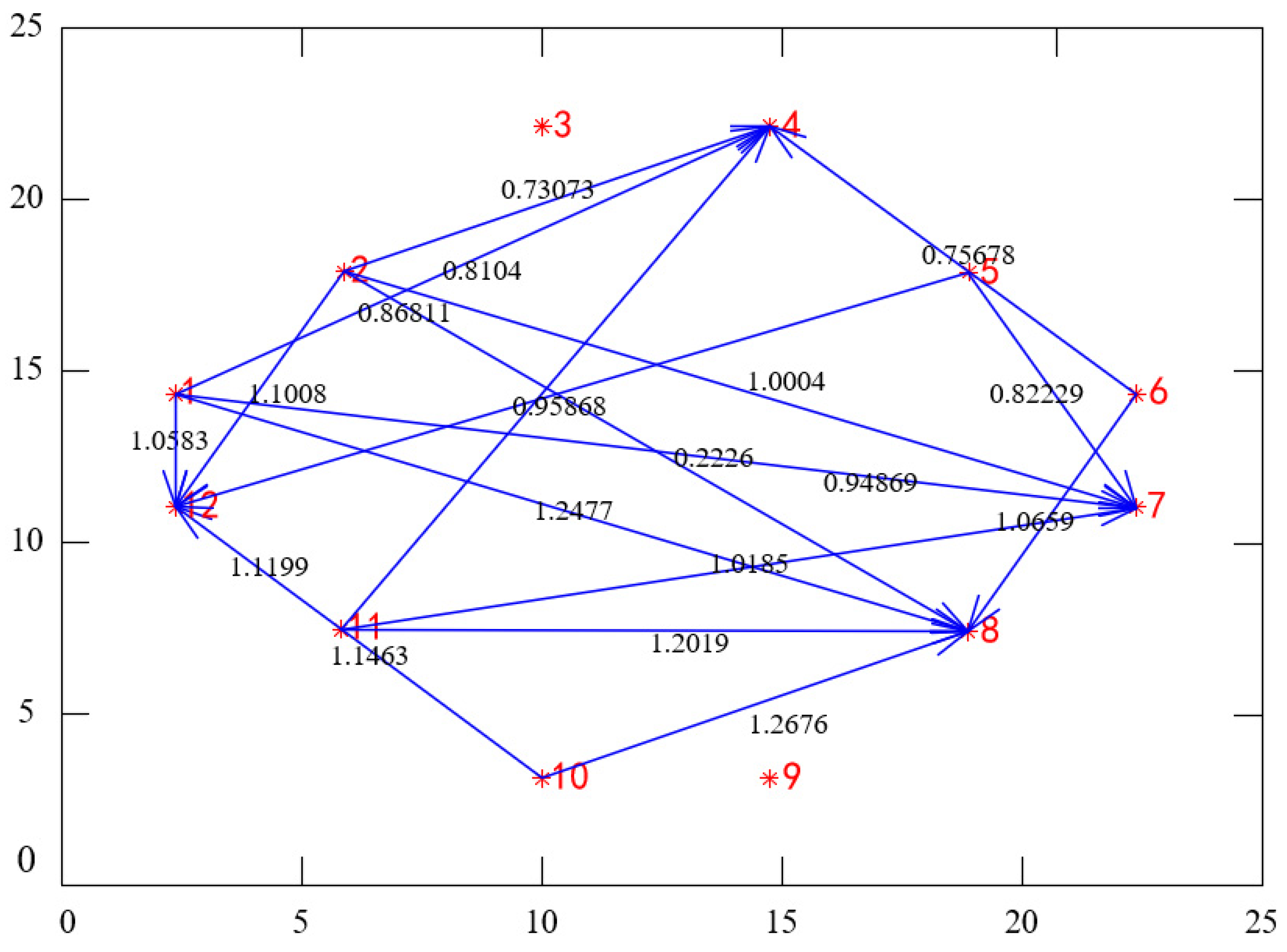
| %Characteristic variable selection | |
| 1 Standardize the data to obtain E0 and F0 | % Equations (1) and (2) |
| 2 Obtain the principal component of the variable | % Equation (3) |
| 3 Determine the number of final extracted components | % Equations (4) and (5) |
| Obtain K variables that have a great influence on membrane fouling | |
| %Membrane fouling detection model | |
| 1 Acquire normal data and train an autoencoder | |
| 2 Obtain the threshold of reconstruction error J0 of normal samples | |
| 3 Use the autoencoder to detect the data collected in real time, and the reconstruction error J is obtained | |
| 4 If J > J0, the membrane fouling exists | |
| % Calculate the transfer entropy between variables | |
| Obtain the influence relationship between variables TY→X | % Equations (9) and (10) |
| % Generate adjacency matrix Akk | |
| for j = 1: k do | |
| for i = j + 1: k do | |
| if Tj→i >0 | |
| Aji= Tj→i | |
| else | |
| Aij= Tj→i | |
| end for | |
| end for | |
| FTT is obtained because the relationship between variables is connected by lines according to the adjacency matrix Akk. | |
| % Simplify fault transfer topology | |
| Set threshold | |
| 1 Select two data segments with a long time distance from historical data of the two variables | |
| 2 Calculate of entropy transfer tei between the above two data segments | % Equation (10) |
| 3 Repeat steps 1 and 2, calculate multiple sets of such transfer entropy NET = [te1, te2,…, tes] | |
| 4 Calculate the average value and standard deviation of NET to obtain the threshold | % Equation (13) |
| Information compressible strategy | |
| 1 Filter all direct and indirect transfer relationships between variables | |
| 2 Calculate the score of the structure for each transfer relationship | % Equations (14) and (15) |
| 3 Choose the transfer relationship corresponding to the highest score | |
| The root causal variables are determined according to the simplified fault transfer topology | |
| Methods | Time (s) | Number of Connections | Accuracy (%) |
|---|---|---|---|
| FTT with ICS and threshold | 8.3 | 18 | 93.4% |
| FTT with threshold | 9.5 | 23 | 91.0% |
| Initial FTT | 14.9 | 66 | 86.7% |
| BN | 12.1 | - | 85.1% |
| ANN | 13.3 | - | 82.3% |
| FL | 19.8 | - | 82.1% |
Disclaimer/Publisher’s Note: The statements, opinions and data contained in all publications are solely those of the individual author(s) and contributor(s) and not of MDPI and/or the editor(s). MDPI and/or the editor(s) disclaim responsibility for any injury to people or property resulting from any ideas, methods, instructions or products referred to in the content. |
© 2024 by the authors. Licensee MDPI, Basel, Switzerland. This article is an open access article distributed under the terms and conditions of the Creative Commons Attribution (CC BY) license (https://creativecommons.org/licenses/by/4.0/).
Share and Cite
Wu, X.; Hou, D.; Yang, H.; Han, H. Compressible Diagnosis of Membrane Fouling Based on Transfer Entropy. Appl. Sci. 2024, 14, 8176. https://doi.org/10.3390/app14188176
Wu X, Hou D, Yang H, Han H. Compressible Diagnosis of Membrane Fouling Based on Transfer Entropy. Applied Sciences. 2024; 14(18):8176. https://doi.org/10.3390/app14188176
Chicago/Turabian StyleWu, Xiaolong, Dongyang Hou, Hongyan Yang, and Honggui Han. 2024. "Compressible Diagnosis of Membrane Fouling Based on Transfer Entropy" Applied Sciences 14, no. 18: 8176. https://doi.org/10.3390/app14188176
APA StyleWu, X., Hou, D., Yang, H., & Han, H. (2024). Compressible Diagnosis of Membrane Fouling Based on Transfer Entropy. Applied Sciences, 14(18), 8176. https://doi.org/10.3390/app14188176








